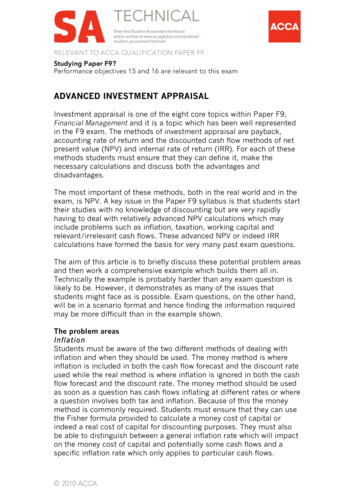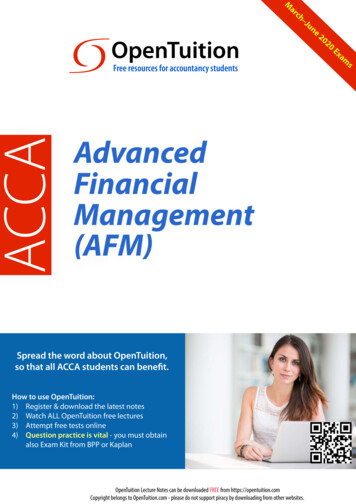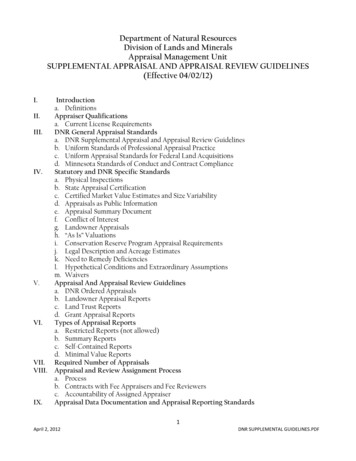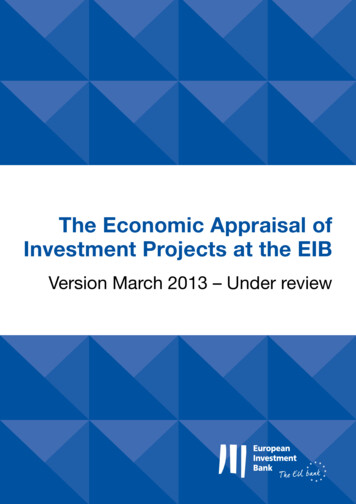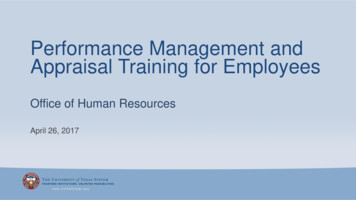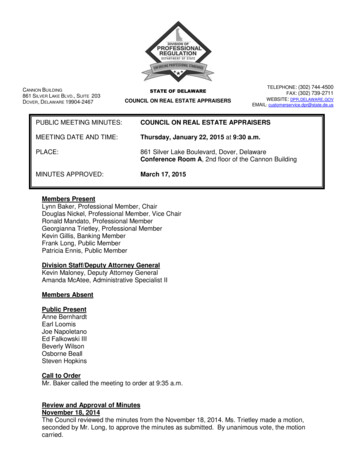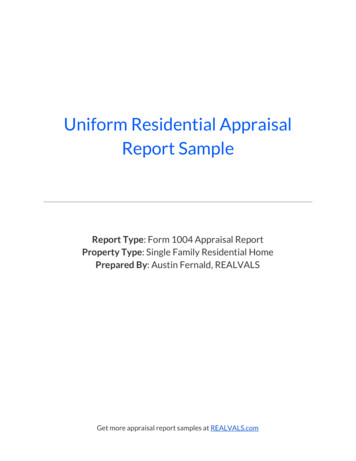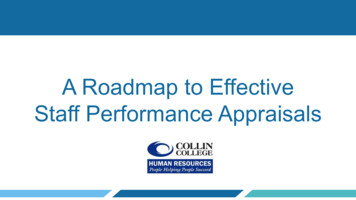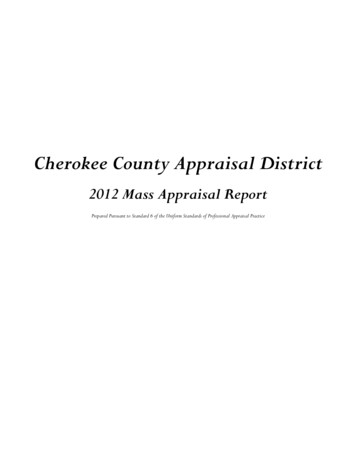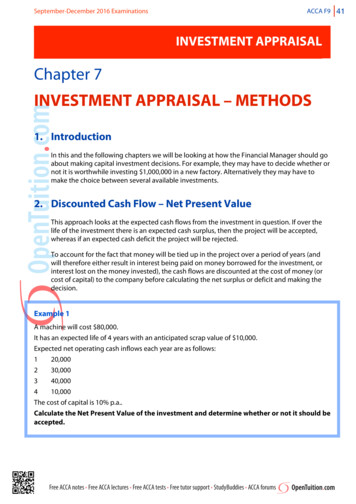
Transcription
ACCA F9 41September-December 2016 ExaminationsINVESTMENT APPRAISALChapter 7INVESTMENT APPRAISAL – METHODS1. IntroductionIn this and the following chapters we will be looking at how the Financial Manager should goabout making capital investment decisions. For example, they may have to decide whether ornot it is worthwhile investing 1,000,000 in a new factory. Alternatively they may have tomake the choice between several available investments.2. Discounted Cash Flow – Net Present ValueThis approach looks at the expected cash flows from the investment in question. If over thelife of the investment there is an expected cash surplus, then the project will be accepted,whereas if an expected cash deficit the project will be rejected.To account for the fact that money will be tied up in the project over a period of years (andwill therefore either result in interest being paid on money borrowed for the investment, orinterest lost on the money invested), the cash flows are discounted at the cost of money (orcost of capital) to the company before calculating the net surplus or deficit and making thedecision.Example 1A machine will cost 80,000.It has an expected life of 4 years with an anticipated scrap value of 10,000.Expected net operating cash inflows each year are as follows:120,000230,000340,000410,000The cost of capital is 10% p.a.Calculate the Net Present Value of the investment and determine whether or not it should beaccepted.Free ACCA notes t Free ACCA lectures t Free ACCA tests t Free tutor support t StudyBuddies t ACCA forums
September-December 2016 ExaminationsACCA F9๏Make sure that you remember the terminology (discount factor; present values; netpresent value), and that you remember how to use the tables given in the examinationfor the discount factors.๏Note that we usually assume that operating cash flows arise at the ends of years. Inpractice it is more likely that the flows are spread over each year, but assuming ends ofyears not only makes the arithmetic simpler, but also looks at a ‘worse-case scenario’with regard to the timing.Example 2In the previous example, what reservations might you have about your investment decision?3. Discounted Cash Flow – Internal Rate of ReturnOne problem in practice with using a Discounted Cash Flow approach to investmentappraisal is that it is virtually impossible to calculate accurately the Cost of Capital for acompany.In the previous example, we decided that using a Cost of Capital of 10% the project wasworthwhile. However, suppose the Cost of Capital was not 10% but 11%. With a higher rate ofinterest we would expect the NPV to be lower. If still positive then we would still be happy toaccept, but if it were negative then we should reject.Even if it is positive at 11%, what about 12%? What about 13%?Because of the uncertainty regarding the Cost of Capital it would be useful to know thebreakeven rate of interest i.e. the rate of interest at which the project would have an NPV ofzero.The rate of interest at which the NPV of the project is zero is known as the Internal Rate ofReturn (IRR).In order to estimate the IRR, we calculate the NPV of the project at two different rates ofinterest and estimate a rate giving an NPV of zero assuming linearity. (In fact the relationshipof the NPV to the rate of interest is not linear but curvilinear. However, the approximationresulting from an assumption of linearity is sufficient for our purposes.Example 3For the project in example 1:(a) Calculate the NPV of the project at an interest rate of 15%(b) Estimate the IRR of the project using your results from part (a) and from Example 1.(c) Interpret the result of (b).Free ACCA notes t Free ACCA lectures t Free ACCA tests t Free tutor support t StudyBuddies t ACCA forums42
September-December 2016 ExaminationsACCA F9 434. Discounted Cash Flow – annuities and perpetuitiesMost examples in the examination are like the one in example 1 - with differing cash flowseach year, each of which needs to be discounted separately.However, you will sometimes be presented with cash flows that are equal each year, in whichcase there is a faster and simpler approach to discounting.An equal cash flow each year (e.g. 10,000 p.a. for 10 years) is known as an annuity.If the annuity were expected to continue for ever, it is known as a perpetuity.4.1. AnnuitiesThe discount factor for an annuity may be calculated using the following formula:Annuity discount factor 1 (1 r) nrWhere:r discount raten number of periodsHowever, it is rare in the examination to need to use the formula because tables are providedfor annuity discount factors.Example 4A machine will cost 45,000 and is expected to generate 8,000 for each of the following 8 years.The cost of capital is 15% p.a.Calculate the NPV of the investment.Example 5The cost of capital is 12% p.a.What is the present value of 20,000 first receivable in 4 years time and thereafter each yearfor a total of 10 years?Free ACCA notes t Free ACCA lectures t Free ACCA tests t Free tutor support t StudyBuddies t ACCA forums
September-December 2016 ExaminationsACCA F94.2. PerpetuitiesThe discount factor for a perpetuity is:1rWhere r rate of interest(These are not provided in tables for you – you must remember the discount factor)Example 6A machine costs 100,000 and is expected to generate 12,000 p.a. in perpetuity.The cost of capital is 10% p.a.What is the NPV of the project?Example 7The rate of interest is 5%. p.a.What is the present value of 18,000 first receivable in 5 years time and thereafter annuallyin perpetuity?5. Other approaches to investment appraisalIn theory, the discounted cash flow approach is the best method of appraisal. This is becauseit considers the cash flows and the timing of these flows. It is cash that is needed to paydividends to the shareholders, and cash that is needed to expand the company by theacquisition of new investments.However, in practice, whatever may be best in theory, shareholders and managers will beinterested in other things – in particular the affect that a new investment will have on theprofits of the business.For this reason, there are many other criteria employed for investment decisions in additionto (or instead of ) discounted cash flow.In your examination, you will be required almost always to use the DCF approach. However,do be aware of two other approaches that are common in practice – Accounting Rate ofReturn and Payback Period.Free ACCA notes t Free ACCA lectures t Free ACCA tests t Free tutor support t StudyBuddies t ACCA forums44
September-December 2016 ExaminationsACCA F9 455.1. Accounting Rate of ReturnThis approach is an accounts based measure and considers the expected profitability of aninvestment.The Accounting Rate of Return (ARR) is defined as:the average profits p.a. from an investment 100%the average book value of the investmentThe ARR is compared with a target rate of return to decide whether or not the investment isworthwhile.The target rate of return will normally be the current Return on Capital Employed for thecompany.Example 8A machine will cost 80,000.It has an expected life of 4 years with an anticipated scrap value of 10,000.Expected net operating cash inflows each year are as follows:120,000230,000340,000410,000Calculate the ARR of the project.Free ACCA notes t Free ACCA lectures t Free ACCA tests t Free tutor support t StudyBuddies t ACCA forums
September-December 2016 ExaminationsACCA F95.2. Payback periodThe payback period is defined as being the number of years it takes for a project to recoupthe original investment in cash terms.The payback period is compared with a target period – if the project pays for itself soonerthen it should be accepted, if not then it should be rejected.The payback period is useful when the future flows have a high level of uncertainty. Thefurther into the future we are forecasting, then the more uncertain the flows are likely to be.By choosing projects with faster payback periods, we are more certain that the projects willindeed end up making a surplus.Payback period and DCF techniques are often combined by calculating a discounted paybackperiod – this involves discounting the cash flows and then calculating how many years ittakes for the discounted cash flows to repay the initial investment.Example 9A machine will cost 80,000.It has an expected life of 4 years with an anticipated scrap value of 10,000.Expected net operating cash inflows each year are as follows:120,000230,000340,000410,000Calculate the payback period of the project.When you finished this chapter you should attempt the online F9 MCQ TestFree ACCA notes t Free ACCA lectures t Free ACCA tests t Free tutor support t StudyBuddies t ACCA forums46
investment. The Accounting Rate of Return (ARR) is defined as: the average profits p.a. from an investment the average book value of the investment 100% The ARR is compared with a target rate of return to decide whether or not the investment is worthwhile. The target rate of return will normally be the current Return on Capital Employed for the
